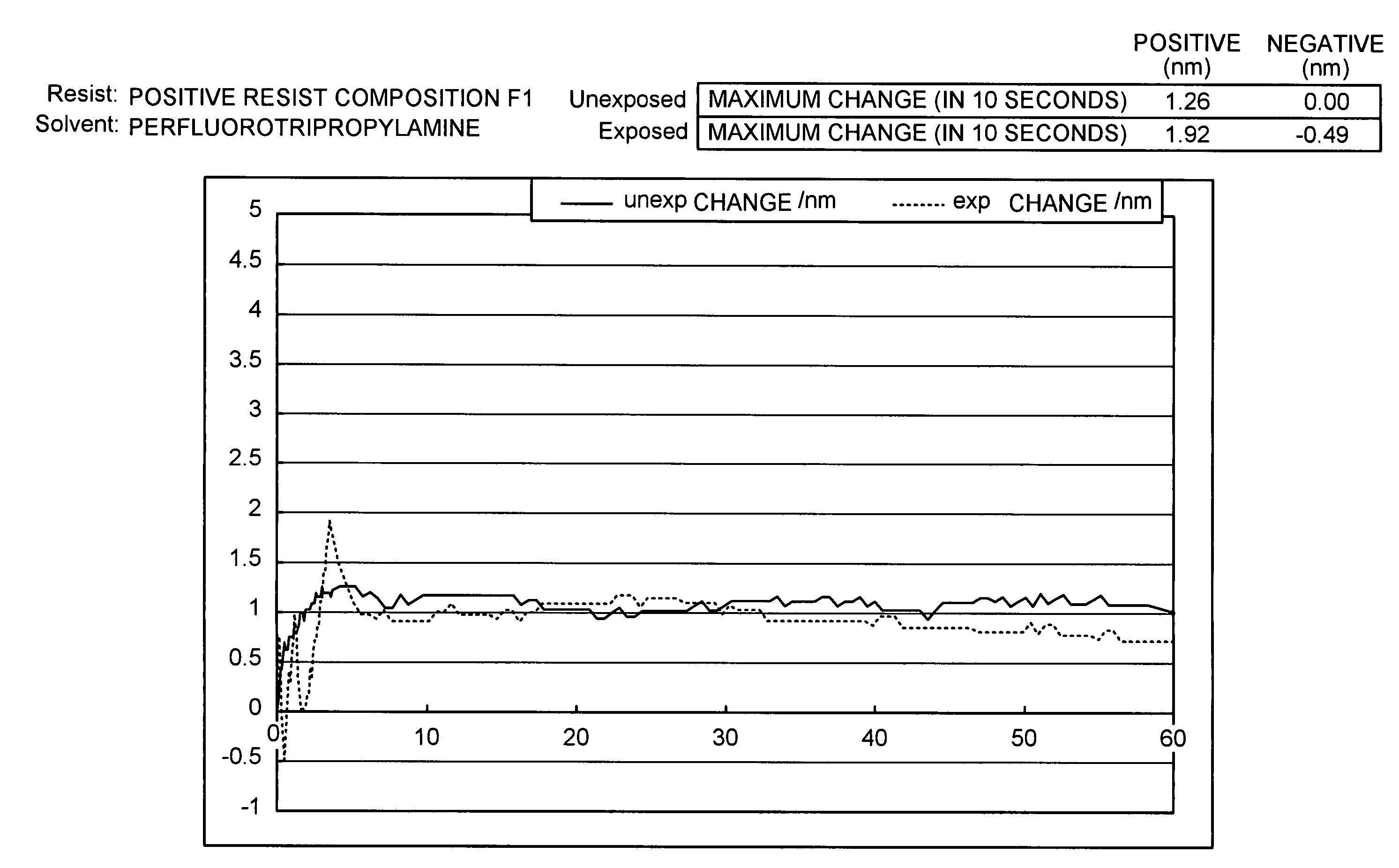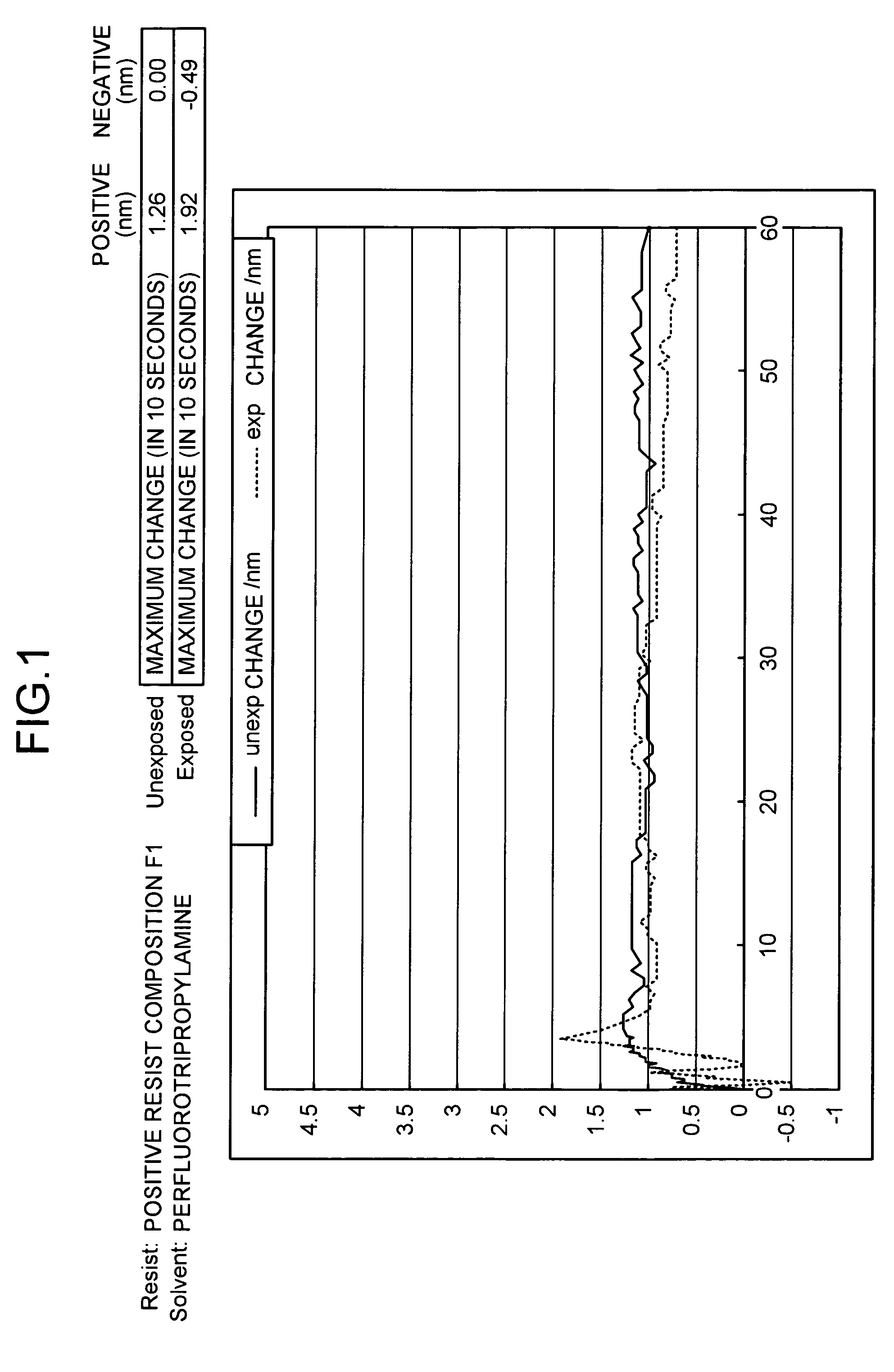Resist composition for liquid immersion exposure process and method of forming resist pattern therewith
a technology of resist composition and liquid immersion exposure, which is applied in the direction of photo-taking process, photosensitive materials, instruments, etc., can solve the problems of resist pattern swelling and sensitivity deterioration, and achieve excellent form stability
- Summary
- Abstract
- Description
- Claims
- Application Information
AI Technical Summary
Benefits of technology
Problems solved by technology
Method used
Image
Examples
reference example 1
[0172]With respect to each of the resist films 1, 2, and 3, a resist pattern was formed by a normal exposure process.
[0173]Specifically, each resist film was selectively irradiated through a mask pattern with an ArF excimer laser (193 nm) by means of exposure system NSR-S302A (manufactured by Nikon Corporation; NA (numerical aperture)=0.60, ⅔ annular illumination). The resist film exposed was then subjected to PEB treatment under conditions at 100° C. for 90 seconds, and subjected to development using an alkaline developer solution at 23° C. for 60 seconds. As the alkaline developer solution, a 2.38% by mass aqueous solution of tetramethylammonium hydroxide was used.
[0174]Thus obtained resist patterns each having a 130 nm line and space of 1:1 were individually examined under a scanning electron microscope (SEM), and their sensitivities (Eop) were determined. Accordingly, it was found that resist films 1, 2, and 3 had excellent cross-section forms having high squareness, and had sen...
example 1
[0175]With respect to each of the resist films 1, 2, and 3, a resist pattern was formed by a liquid immersion lithography process using pure water as an immersion liquid.
[0176]Specifically, each resist film was selectively irradiated through a mask pattern with an ArF excimer laser (193 nm) by means of exposure system NSR-S302A (manufactured by Nikon Corporation; NA (numerical aperture)=0.60, ⅔ annular illumination). In a simulated immersion lithography treatment, while rotating the silicon wafer having the resist film exposed, pure water at 23° C. was allowed to fall dropwise against the resist film for 2 minutes. Subsequently, the resist film was subjected to PEB treatment under conditions at 100° C. for 90 seconds, and subjected to development using an alkaline developer solution at 23° C. for 60 seconds. As the alkaline developer solution, a 2.38% by mass aqueous solution of tetramethylammonium hydroxide was used.
[0177]Thus obtained resist patterns each having a 130 nm line and ...
example 2
[0178]With respect to each of the resist films 1, 2, and 3, a resist pattern was formed by a liquid immersion lithography process using a fluorine compound solution (perfluoro(2-butyltetrahyrofuran) having a boiling point of 102° C. as an immersion liquid.
[0179]Specifically, each resist film was selectively irradiated through a mask pattern with an ArF excimer laser (193 nm) by means of exposure system NSR-S302A (manufactured by Nikon Corporation; NA (numerical aperture)=0.60, ⅔ annular illumination). In a simulated immersion lithography treatment, while rotating the silicon wafer having the resist film exposed, the perfluoro(2-butyltetrahydrofuran) described above at 23° C. was allowed to fall dropwise against the resist film for 2 minutes. Subsequently, the resist film was subjected to PEB treatment under conditions at 100° C. for 90 seconds, and subjected to development using an alkaline developer solution at 23° C. for 60 seconds. As the alkaline developer solution, a 2.38% by m...
PUM
| Property | Measurement | Unit |
|---|---|---|
| width | aaaaa | aaaaa |
| thickness | aaaaa | aaaaa |
| wavelength | aaaaa | aaaaa |
Abstract
Description
Claims
Application Information
 Login to View More
Login to View More - R&D
- Intellectual Property
- Life Sciences
- Materials
- Tech Scout
- Unparalleled Data Quality
- Higher Quality Content
- 60% Fewer Hallucinations
Browse by: Latest US Patents, China's latest patents, Technical Efficacy Thesaurus, Application Domain, Technology Topic, Popular Technical Reports.
© 2025 PatSnap. All rights reserved.Legal|Privacy policy|Modern Slavery Act Transparency Statement|Sitemap|About US| Contact US: help@patsnap.com



